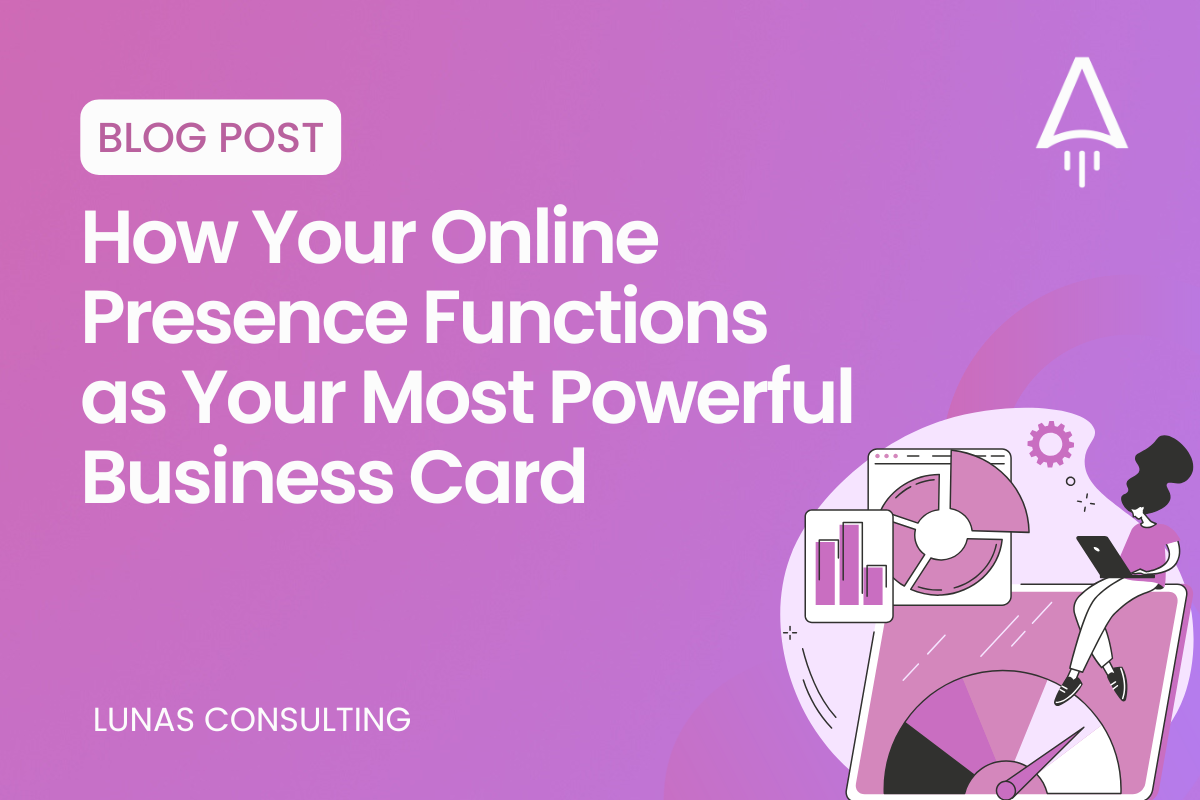How Your Online Presence Functions as Your Most Powerful Business Card
Learn to craft a digital identity that builds trust, demonstrates expertise, and drives business growth.
Learn to craft a digital identity that builds trust, demonstrates expertise, and drives business growth.

In just three seconds, your online presence creates a lasting first impression that determines whether customers trust your business. That's less time than it takes to hand someone a traditional business card, yet the impact reaches exponentially more people.
The challenge of digital first impressions in today's connected world goes beyond having a website or social media profile. Every Google search, every social media visit, and every online interaction shapes how potential customers perceive your professionalism and credibility. Unlike paper business cards tucked away in drawers, your digital presence works around the clock, making impressions you'll never witness.
This guide reveals how to transform your online presence into a powerful digital business card that opens doors, builds trust, and drives growth. From crafting cohesive brand identity to optimizing every digital touchpoint, you'll learn to make those crucial three seconds count. Let's explore how modern professionals leverage digital presence to create lasting business relationships.

Traditional business cards served their purpose well for centuries—a tangible reminder of a meeting, complete with contact information and company branding. But their limitations have become increasingly apparent in our digital age.
Paper cards work only when physically exchanged, limiting reach to in-person encounters. They're easily lost, damaged, or forgotten in jacket pockets. Most critically, they provide only static information frozen at printing time, unable to showcase work samples, customer testimonials, or real-time updates.
The digital transformation of professional networking changed everything. Your online presence now serves as a dynamic, always-accessible business card that prospects can discover independently. When someone hears about your business, they don't wait for a networking event—they search online immediately.
This always-available nature fundamentally changes professional relationship building. Your digital business card works while you sleep, introduces you to people you'll never meet, and provides far richer information than any paper card could contain. It's not replacing traditional cards—it's revolutionizing how professionals connect and build credibility.
The three-second rule for website evaluation isn't arbitrary—it reflects how quickly humans form judgments online. Within those fleeting moments, visitors assess professionalism, trustworthiness, and relevance. They're not consciously analyzing; they're reacting instinctively to visual and structural cues.

Visual design impact on credibility proves more powerful than most businesses realize. Professional design signals established business practices, attention to detail, and investment in customer experience. Conversely, outdated design or amateur appearance triggers doubt about business viability and service quality.
Information accessibility determines whether interested visitors become customers. If contact information requires hunting, services remain unclear, or navigation confuses, visitors leave for competitors who make engagement effortless. Clear, intuitive access to crucial information respects visitor time and demonstrates customer focus.
Critical elements evaluated in those first three seconds:
Understanding these snap judgments helps prioritize improvements that dramatically impact first impressions.
Unlike traditional cards limited to basic information, digital business cards encompass multiple components working together to create comprehensive professional identity.
Your website anchors all other digital presence elements. The About page tells your story, transforming faceless business into relatable people with missions and values. This narrative connection often determines whether prospects choose you over technically similar competitors.
Service and product presentations go beyond simple listings to demonstrate value through benefits, outcomes, and proof. Clear descriptions, compelling visuals, and strategic organization guide visitors toward engagement. Think of each page as a conversation with potential customers.
Contact information clarity seems basic yet many businesses complicate this crucial element. Phone numbers, email addresses, contact forms, and physical locations should appear consistently across every page. Make connecting with you the easiest action visitors can take.
Professional photography elevates perception instantly. Real photos of your team, workspace, and products create authenticity that stock images can't match. Invest in quality visual representation—it pays dividends in credibility.
Social media profile consistency reinforces professional identity across platforms. Matching profile photos, aligned descriptions, and coordinated branding create recognition and trust. Inconsistency suggests disorganization or, worse, potential illegitimacy.
Online business listing accuracy ensures consistent information wherever customers find you. Name, address, phone number, and hours must match exactly across directories. These citations influence both search rankings and customer confidence.
Trust online builds through multiple signals working together. No single element creates credibility—it emerges from comprehensive professional presentation.
Professional design elements extend beyond aesthetics to functionality. Secure connections (HTTPS), professional email addresses (not Gmail or Yahoo), and error-free content signal established business operations. These details matter more than businesses often realize.

Customer testimonials and reviews provide social proof that advertising cannot replicate. Feature specific stories with real names and photos when possible. Video testimonials create even stronger connections. Let satisfied customers sell for you through their authentic experiences.
Industry certifications and credentials belong prominently displayed, not buried in footer links. Professional memberships, awards, and accreditations provide third-party validation of expertise. Don't assume visitors know your qualifications—showcase them clearly.
Consistent brand messaging across all content reinforces professionalism. From website copy to social media posts, maintaining unified voice and values builds recognition and trust. Mixed messages confuse while consistency comforts.
A tip from us: Create a brand style guide documenting colors, fonts, tone, and messaging. Reference it whenever creating content to ensure every touchpoint reinforces your professional identity consistently.
Strong brands command premium prices and customer loyalty. Online branding transforms small businesses into memorable entities that stand out in crowded markets.
Visual brand consistency across platforms creates instant recognition. Your logo, colors, and design elements should remain identical whether visitors find you through Google, Facebook, or industry directories. This visual thread connects all touchpoints into cohesive identity.
Voice and tone development goes beyond what you say to how you say it. Professional yet approachable? Expert but accessible? Define your brand personality then maintain it consistently. This human element differentiates beyond visual design alone.
Logo and color scheme standardization prevents the amateur appearance of slightly different versions across platforms. Create official brand assets in various formats and sizes. Document exact color codes and usage guidelines. Professional presentation requires precision.
Professional photography and graphics investment returns exponentially through enhanced credibility. Custom visuals outperform generic stock photos by creating unique brand identity. Budget constraints shouldn't eliminate visual quality—creativity can compensate for limited resources.
Websites function as always-open storefronts where customers form opinions and make decisions. Every element either builds confidence or creates doubt.
Homepage optimization strategies focus on immediate value communication. Within seconds, visitors should understand who you are, what you offer, and why they should care. Clear headlines, compelling value propositions, and obvious next steps guide visitor journeys.
Navigation and user experience determine whether interested visitors become customers. Intuitive menu structures, logical page organization, and clear pathways prevent frustration. Test your site with fresh eyes—what seems obvious to you might confuse newcomers.
Mobile responsiveness importance cannot be overstated when most searches originate from smartphones. Sites must work flawlessly on all devices, not just tolerate mobile viewing. Design mobile-first, then scale up for larger screens.

Loading speed impact on impressions proves decisive for impatient modern users. Every second of delay loses visitors and sales. Optimize images, minimize code, and invest in quality hosting. Speed equals professionalism in digital contexts.
Social platforms evolved from personal sharing spaces to professional networking powerhouses. Strategic presence builds relationships impossible through traditional networking alone.
Platform selection for your industry prevents wasted effort on inappropriate channels. LinkedIn dominates B2B networking, Instagram showcases visual businesses, and Facebook builds local community connections. Quality engagement on fewer platforms outperforms weak presence everywhere.
Professional profile optimization transforms casual accounts into business assets. Complete every profile section, use high-quality images, and write compelling descriptions. Treat profiles as mini-websites deserving careful attention.
Content strategy for credibility shares value before selling. Educational posts, industry insights, and helpful tips position you as a trusted resource. Sales messages feel natural when followers already value your expertise.

Engagement and community building create relationships that transcend transactions. Respond to comments, participate in discussions, and support others' content. Digital networking mirrors in-person relationship building—give before expecting returns.
For local businesses, Google Business Profile often provides first impressions before websites. This free tool deserves premium attention given its search prominence.
Complete profile optimization goes beyond basic information to showcase personality. Use every available feature: services, attributes, products, and posts. Comprehensive profiles rank higher and convert better than minimal listings.
Professional photo selection dramatically impacts click-through rates. Cover photos, logo placement, interior shots, and team images create visual stories. Google provides photo guidelines—follow them for optimal display across devices.
Customer review management demonstrates active business engagement. Respond professionally to all reviews, thank positive reviewers specifically, and address concerns constructively. These public interactions show prospects how you'll treat them.
Regular updates and posts keep profiles fresh and engaging. Share updates, offers, and events to maintain visibility. Google rewards active profiles with better rankings, creating a virtuous cycle of engagement and visibility.
A tip from us: Set a monthly reminder to update your Google Business Profile photos and posts. Fresh content signals active business operations and improves local search visibility significantly.
Reviews replaced personal recommendations as primary trust signals. Managing online reputation requires proactive strategies rather than reactive damage control.
Review platform presence extends beyond Google to industry-specific sites. Identify where your customers leave reviews then claim and optimize those profiles. Incomplete profiles on review sites undermine credibility.
Response strategies for feedback demonstrate professionalism publicly. Thank positive reviewers by name and mention specific details they appreciated. For negative reviews, acknowledge concerns, apologize if appropriate, and offer resolution paths offline.
Encouraging positive reviews requires systematic approaches without violating platform rules. Follow up with satisfied customers, make reviewing easy through direct links, and explain how reviews help small businesses. Never offer incentives or fake reviews—authenticity matters more than quantity.
Managing negative feedback professionally turns potential disasters into trust-building opportunities. How you handle criticism reveals character more than praise does. Stay calm, factual, and solution-focused in all responses.
Content marketing establishes authority more effectively than any self-proclaimed expertise. Demonstrating knowledge through valuable content builds trust organically.
Blog content for thought leadership answers questions your customers ask. Share insights, explain industry trends, and provide actionable advice. Each post positions you as the expert customers trust with their business.
Case studies and success stories prove capabilities through concrete examples. Detail challenges faced, solutions implemented, and results achieved. Specific metrics and outcomes create compelling proof of expertise.

Educational resources provision goes beyond selling to teaching. How-to guides, templates, and tools demonstrate generosity while showcasing knowledge. Customers remember businesses that helped them succeed.
Industry insights sharing keeps you relevant and visible. Comment on trends, analyze changes, and predict futures. Position yourself as someone worth following for valuable perspectives.
Transformation requires systematic implementation. This action plan provides structure for building powerful digital business presence.
Current presence audit reveals gaps and opportunities:
Priority improvement areas typically include:
Implementation timeline maintains momentum:
Your online presence serves as a perpetual first impression machine, working tirelessly to build or break trust with potential customers. Unlike traditional business cards limited by physical exchange, your digital presence scales infinitely while providing rich, dynamic information that static cards never could.

The three-second judgment window demands excellence across every digital touchpoint. Professional design, consistent branding, accessible information, and social proof combine to create compelling digital identity. Each element reinforces others, building credibility that translates into business growth.
Starting improvements feels overwhelming until you begin. Focus first on claiming and optimizing free profiles, then systematically enhance each component. Perfect digital presence isn't the goal—professional, consistent, and helpful presence is. Your digital business card awaits creation.
Interested in improving your skills and learning more about business operations to generate and convert leads? Check out the following articles:
Essential Online Presence Tools Every Business Owner Should Use in 2025
SaaS Recovery Strategies When Go-to-Market Fit Falls Apart
The Complete Beginner's Guide to Building Your Online Presence from Scratch
Strategic Timing When to Prioritize Go-to-Market Fit Over Product-Market Fit
B2B Go-to-Market Fit Analysis Framework for Accelerated Business Growth
We have a lot more for you. Click the button below to sign up and get notified when we release more content!
View more